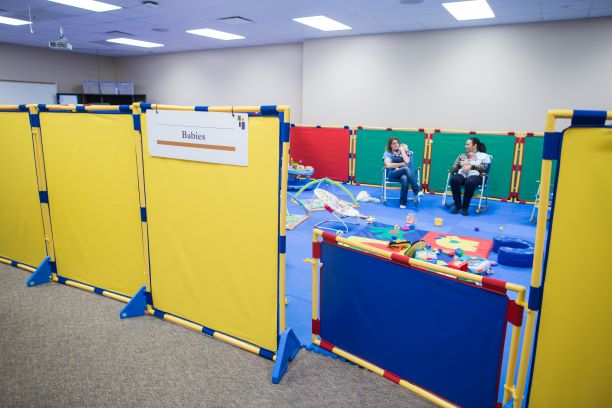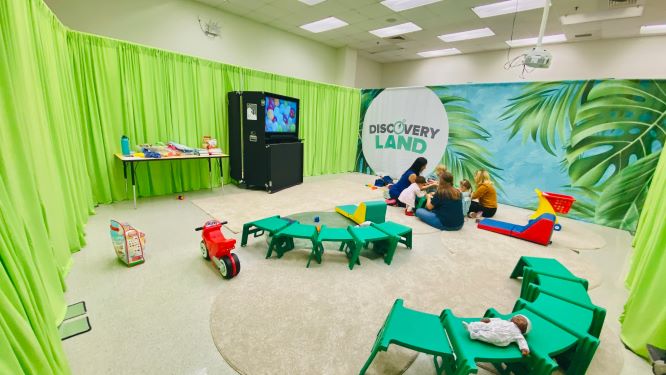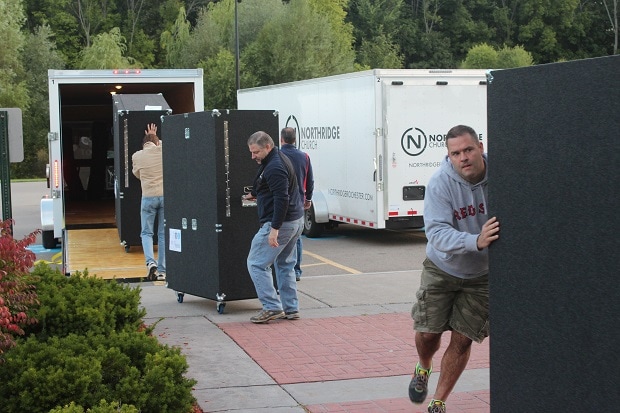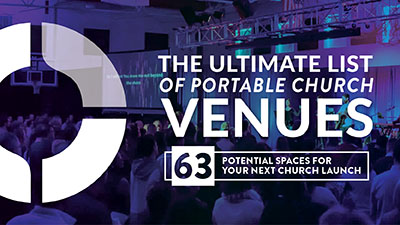
Multisite, Multisite Resources
When God blesses a (church) leader with a clear and compelling vision, they have been given access to a unique and unmatched power.
***
Unfortunately, I am old enough to reminisce about the original “Adventures of Superman” created in the 1950s. (But proudly, I am young enough to have only viewed them as reruns in the 1960s!)
It may seem odd, but I attribute some of my sense of “truth, justice and the American Way” to Superman. Indeed, it was a simpler time back then. It didn’t take much to capture the imagination of the American public—just a man who possesses otherworldly powers to do what needed to be done. No matter what evil came along, Superman was up to the task of making everything right again. Now that’s power!
But then kryptonite was introduced to the storyline! It was the fictional material that emitted peculiar radiation that drained Superman of his power. Fun fact here—22 forms of kryptonite were used to render Superman powerless in various ways over the life of the series!
Again – When God blesses a (church) leader with a clear and compelling vision, they have been given a kind of power that allows for some amazing things to happen in and through the local church. We don’t see (church) leaders “leaping tall buildings with a single bound,” but we can see them communicating and executing a great and powerful God-given vision.
One of the strategies He has blessed for the last four decades is that of multisiting. God blesses the strategies that help deliver a vision for a strong and growing Kingdom. Hope is delivered to new communities in the form of healthy people undeniably being the light and salt in their own neighborhoods.
Then Kryptonite! Ugh!!
The early pioneers of the “Multisite Movement” were given a powerful vision. After almost four decades of innovating and executing this strategy, multisite has proven to be an effective tool for stimulating growth in the church. Today, there are some local churches just knocking it out of the multisite-park so to speak.
BUT, AS IT SEEMS, ALL POWERS HAVE A KRYPTONITE!
Very real speedbumps in the form of organizational chaos and financial stress from real estate and property expenses can quickly threaten the progress of even the most powerful vision. About the latter, churches are regularly making vision-altering decisions due to the influences of untenable property expenses (kryptonite). Executive team leaders are declaring, “Right now, today, we are losing money on a property that we can’t afford.” And it is desperate claims such as this that call the church back to a manageable and balanced property portfolio – especially in a multisiting strategy that is adding campuses.
Is your church’s property portfolio consistent with the Kingdom vision God has given you?
The Kryptonite of Multisite Momentum is a new FREE RESOURCE designed for church leaders blessed with a white-hot vision for kingdom growth. Check out the story of how one church faced one of its threats of kryptonite and is winning.
Complete this quick form for instant download

Helpful References, Leadership
Leadership is more than just being the highest guy on the totem pole. Whether you’re a campus pastor, senior leader, or active volunteer, you can have a voice even when you’re not the one in charge.
Here are some of our favorite articles with great ideas on how to lead when you’re not the senior leader.
- Leading When You’re Not In Charge
- 6 Ways to Lead a Church When You Don’t Get to Preach
- 5 Key Leadership Traits of a Great Campus Pastor
- What Makes a Great Campus Pastor
- 8 Things I Would Say to a Struggling Pastor
- 8 Habits of a Highly Effective Campus Pastor
What’s your best advice for campus pastors? Leave a comment below and let us know.

Children's Ministry, Volunteers
A deep dive into kids ministry ratios…How many kids to expect for your launch, how much space will you need for the kids and the number of workers/volunteers you will need to keep everything safe and functioning well.
So let’s start at the beginning. How many kids should you expect to have in your kids ministry?
As a general rule of thumb, we tell churches to expect 2% of their anticipated congregation per birth year of your church to be kids. What that means is …if you are expecting 100 people, you should expect 2 kids to be in the 0-12 months age range, 2 kids in the 1 year -2 year age range, and so forth. This rule may vary depending on the type of community you are launching in but for the most part, this is what churches are reporting. So once you calculate 2% of your expected congregation, you can then figure out the best way to group the ages and how many classrooms you need.
Two things to highlight while thinking through this is your pastor’s age and the community you live in. We have found that 80% of your church age is within the life stage of your pastor or younger. Meaning, if you as the pastor are 30 years old, 80% of the people attending your church will be in the same or close to the same life season as you. In this example, you will likely have a much larger nursery and elementary than middle or high school. So consider how old the children of the pastor are and that can help you gauge what ages you will likely have. As another example, think about any older mega church. The average age of the church has continued to go up as the lead pastor has also gone up in age (20 years ago the average of the church congregation was 20 years younger than it is now, and so on). This really only impacts your church’s needs if you are a much younger pastor or if you are a pastor with kids out of college.
Next, how much space will you need for your kids ministry?
Let’s talk about how much space you need per a child, per age group. According to the author and consultant Judith Colbert, Ph.D., 35 sq ft of usable indoor space per child and 75 sq ft of outdoor space is what is required when getting licensed for a daycare. The good news is that churches are not held accountable to the same standards as daycares because you have the children for much shorter amounts of time. However, Colbert continues on to say that if you have too much room for children they can have a hard time staying focused and calming down, and if you have too little space for children it can cause chaos, conflict, and a higher risk of spreading sickness. In portable church setups, since you are not liable to the licensing rules, we have consistently found roughly 50 sq feet of space per child to be sufficient and comfortable.
To break it down further…
A typical classroom in a school is 30′ x 30′ which is a total of 900 square feet. So divided by 50 sq ft you are capable to fit about 18 kids in that space. Once you factor in table and desks lined up along the walls you have less space and can not necessarily fit 18 children, so we suggest that 15 children (max) per acoustic space is ideal.
In the nursery room, what feels more comfortable is about 10 children. Parents and workers feel more comfortable when the classroom is not crowded and it also allows you to divide the room into a section for crawlers and a section for sleepers.
For the toddler’s room, 12 kids are the suggested limit. This allows for more space to include larger toys for gross motor skills and room for more active play!
For the preschool room, you can fit 15+ children because they don’t require as much space, you can interact with them more directly, and you are able to engage them in groups at tables, for snacks, storytime, crafts, etc.
For elementary-aged classrooms, it is completely different. And this depends largely on the format you are doing with your students. Here is what we suggest:
- Large group format – 50+ Sq. Ft. per student
- Large area for staging, teaching, kids
- Breakout spaces for small groups
- Game Format – 40+ Sq. Ft. per student
- Medium-sized area for play area
- Breakout spaces for small groups
- Curriculum format – 30 Sq. Ft. per student
- Smaller area for gathering
- Can combine more kids in smaller space, especially after 2nd grade once kids hit the readings level grades
Lastly, how many workers to kids will you need?
The child to volunteer ratio in typical settings allows for more kids per worker. However for portable environments, venues aren’t normally laid out exactly per a church’s needs, so more conservative ratios are chosen. With that in mind, our minimum suggested ratios are:
- 0 – 36 Months Old — 1:3 Ratio
- 3 – 5 Years Old — 1:7 Ratio
- K – Elementary — 1:15 Ratio
Another tip we live by — At least 2 people in every room at all times. If you don’t have bathrooms in the rooms with you, this can present a problem for accountability, safety, and security. We addressed this further in another kids ministry blog, read that post here.
To sum it up…
Yes, these are ideal situations, and can’t always be perfect. We understand that things have to flex, and you will need to consider your demographics, your community, and your launch team. But we hope that this will provide you with somewhere to start as you continue to prepare for your church launch.
As always, our church launch specialists are here to be a resource to you. They will use their experience as well as our resources to make sure you feel as comfortable as possible before you launch. So if you have any more questions on this please let us know how we can help!

Children's Ministry
Portability Hacks & Tips – How to Keep Your Kids Ministry Secure
There is a peace that parents need to feel when it comes to leaving their children at church. You will want to create environments where parents want to leave their kids and where the kids don’t want to leave!
These are environments where kids will have fun, learn about God, and be safe! This blog post and the corresponding, much more in-depth (do watch), video talk about the most important things you need to keep in mind when you set up your portable church every week.
1. In a portable church, security starts when the first set-up team person arrives and does not end until the very last child walks out of the building.
This is critical and can be easy to forget when you get busy with set up, but as soon as children are at your venue, you need to have security set up. Volunteers bring their kids in the early morning for set-up and they often roam unattended. Have your whole set-up team be focused on security as well as set-up, or even better, have a person dedicated to it!
2. Recruit people for your security team who are more confrontational.
You don’t want a security team member who runs from confrontation because they will have a difficult time if a hard situation arises. The video discusses certain personality types that would be good for this role. Have your team take a Meyer Briggs or Enneagram test and seek out personality types to fit the role.
3. Have a minimalist room quickly set up for volunteer kids.
This is a small, safe place that you set up first, where parents can drop their kids when they are setting up the rest of your church. It is typically a small room with the basics, a TV playing and a handful of toys, for kids up to age 8 or 10. Children older than that are encouraged to help set up the rest of the church.
4. Put your entire kids ministry environments behind an area of the venue that can be “locked down”.
Ideally, you will be able to put your kids ministry in rooms down just one or two hallways with a security team member at each entry point. If you are meeting in classrooms that have doors to the outside, it is important to ensure they remain locked to the outside with entry controlled by the teachers in the class.
5. Bathrooms should be sectioned off as part of the secure area.
Ideally, you will want to have completely separated children’s bathrooms as a part of your secure area. Even if you are unable to secure a bathroom in the “locked down” area of your kid’s ministry, work to find bathrooms separate from the adult bathrooms. This keeps both kids and adults safe as well as makes your kid’s ministry volunteer job easier.
6. Dual volunteers are critical.
Classrooms – We highly recommend a minimum of 2 volunteers in every space. If you don’t have enough volunteers to have 2 in each classroom, combine classrooms until you do. This allows for better communication and accountability
Restrooms – If your restrooms aren’t attached to the classroom (are down a hallway, etc), it is important to have two volunteers go for accountability. When that can’t be done to ensure the volunteer stands outside the doorway and does not go in alone with them. In the case where a child needs help in the restroom and they have to go in, they should let another volunteer know they are are going in.
7. Having a hallway roamer to fill in anywhere that is needed is always a good idea.
This person is a general “over watcher” making sure everything is okay from classroom to classroom and helping out where necessary in situations listed in point 6. They can also help check in a child who arrives late or fill any need that arises.
8. Rotating numbers on your check-in system.
Making the mistake of having the same number week after week leaves room for someone else to knows your child’s number and try to sign them out of class. This can be especially tricky in a situation where parents are in a custody battle, so having this in place before something happens is critical! Even if you can’t afford a system that does this automatically, you can still use a manual system that does the same.
9. Background checks!
Kids workers & security team members need to clear all security checks. This is a precaution that really eliminates any surprises and sets you up for success. Plus this provides huge peace of mind to the parents. Checker through Planning Center works great, or you can often do them through your local sheriff’s department. Re-check your teams every 1-3 years or if they take long breaks from serving your church. This should never be a “one and done” check. Along the same lines, it is okay to ask them to provide references too.
10. All kid’s workers should be identified.
Lanyards, name tags, vests, t-shirts, etc. whatever the DNA of your church is, you need to make it clear who the kid’s ministry teams are and who the security teams are.
11. Have your Security Procedures well documented and readily available.
Also, ensure your teams regularly review the documents and have your security lead ensure it is being followed. An easily accessible document builds confidence for both your security team as well as the parents.
Bonus Tip: Start at launch!
You may think, do I really need to have security form day 1? And the answer is yes. You have invested too much into your church launch to not make absolutely sure your kids are safe. First impressions are critical and your community will notice (especially those who aren’t churchgoers) if you don’t have a secure kids ministry and it will impact if people want to come back to your church.
All of these lessons have come from years and thousands of churches’ experiences. We hope that this helps you as you think through how to make your kids ministry as safe as possible.

If you have any other suggestions of questions about kids’ ministry security let us know! We’d love to hear your experience with kids ministry security in a protable church. And to check out our kids ministry gallery, click here.

Equipment, Portable Church Systems
Finding the right equipment for your portable church is no easy task! Space, storage and transportation are just a few of the factors that have to be taken into account. In addition, setting up and tearing down equipment every week can be a unique challenge.
You need equipment that is best suited for your specific portable church needs. How can you make sure that you don’t mess it up? You can start by keeping these seven key pointers in mind:
1. Costs involved
Choosing the right portable equipment can save your church thousands of dollars! However, in order to make that correct choice you need to get your numbers right. Don’t forget to take into account the following costs:
- Individual equipment pieces
- Rent and other venue-related expenses
- Storage and transportation
- Equipment wear and tear
- Replacement of equipment
For example, if your church pays rent by the hour, you should especially be mindful of the setting up and tearing down time, when choosing your equipment.
2. Venue facilities and limitations
No two portable churches have the same equipment needs. For example, a church that meets in a school might not need chairs, whereas a movie theater church might not require a projector and staging.
Before you choose any equipment or utilize the facility’s systems, remember to ask the following questions:
- Will the setup be the same each week? Or, will we need to move our equipment to different parts of the facility?
- What are the landlord’s expectations regarding payment for any damage or repairs of equipment?
- If we need to use another part of the facility, will we be able to move the permanently installed equipment there?
- Will the facility’s electrical capacity be able to handle all the equipment?
Answering these questions will bring you a step closer to picking out the right equipment for your facility.
3. Setting up and tearing down
Installing and packing up equipment is a key element of the portable church experience. While this weekly exercise encourages a healthy volunteer culture, it can be tiring and frustrating for your team. You can avoid that by making sure that your equipment allows for efficient and easy setting up and tearing down.
Before zeroing down on the equipment for your mobile church, here are a few crucial things to consider:
- How much time will it take for setting up and tearing down this equipment? How many people will I have for our set-up and takedown teams? And, how much time does our team have at its disposal, both before and after the service?
- Will it be easy for volunteers to carry equipment in, around and out of the building?
- Does handling this equipment need special skills? Or, can volunteers be easily trained to install, use, and put it away?
The right church equipment, if coupled with proper management and regular motivation, will drastically reduce any chances of volunteer burnout.
4. Proper storage
Storage – or the lack of it – is a key determining factor while choosing your portable church equipment. While a few rented venues offer on-site storage, most require the church equipment to be brought in and taken out each week. Therefore, it is important that the equipment you choose allows you to:
- Store it in a safe manner.
- Stay within your allotted storage space.
- Keep your storage space costs to a minimum.
- Have some free space for storing additional equipment.
The amount, nature and cost of storage will help you choose the best-suited equipment for your church needs. For example, you might need to invest in special storage cases, either a shipping container or a trailer, to ensure that your equipment remains safe.
5. Efficient transportation
The weight, size, and volume of your portable church equipment have a direct impact on transportation logistics. Here are a few key questions to ask beforehand:
- Is the facility accessible via both stairs and elevator(s)?
- Will the team be able to load and unload the equipment in the truck/trailer safely and efficiently?
The experts at Portable Church Industries have helped hundreds of mobile churches with efficient storage and transportation plans. Our customized rolling storage cases are designed to safely store and transport all your equipment – for years to come! And, at times when on-site storage for these cases can’t be negotiated with the landlord, our custom-made cargo trailers will make sure that all your valuable equipment stays safe.
6. Durability and safety
An important factor that needs to be taken into account is the life of the equipment. It might be a wiser decision to invest in slightly more expensive equipment if it will last longer. Don’t forget to ask these crucial questions:
- Will the equipment need to be upgraded every few years?
- Is it made with safe and durable material? Will it withstand the rigors of the road and will it sustain under weekly set-up and occasional drops?
The equipment that you get for your portable church – right from the chairs and projector to the audio and lighting systems – must be reliable and long-lasting.
7. Appeal and comfort
Finally, your equipment will be used by your teams every week. Therefore, it’s key to ensure that they are able to use it comfortably and efficiently – and have fun while doing so! Make sure that the equipment checks all these boxes:
- Comfort
- Appeal
- Ease of use
- Durability
Don’t forget to ask for your teams for suggestions before sealing the deal. For example, your worship leader might have some ideas about specific brands for the sound desk and mics.
The equipment requirements in a portable church environment are vastly different from those in a permanent church building or even a touring band.
Thankfully, the experts at PCI have been providing customized equipment solutions to portable churches for over 25 years.
Our balance equipment solution for your church will ensure that ALL aspects are taken into account. We’ll find the right piece of equipment for the right application, and if we can’t find a part – we’ll invent it ourselves!
So, give us a call today at 800.939.7722, and we’ll design and deliver the perfect equipment solution for your portable church!


5 Minute Monday, Facility, Vlog
Our new resource – The Ultimate List of Portable Church Venues – talks about all the different potential spaces you could use for your next campus launch or your church plant.

We developed this resource in response to the question we get all the time – where should our church launch?! So – if you find yourself wondering that very thing, this was created with you in mind.
Outlined in the resource are 63 potential spaces you could set up a portable church in. The bolded venues are the ones that are commonly used for portable churches and all the other venue options may not be used all the time but they are all locations that we have helped churches launch in. Something to note is that not every location on this list is going to connect with you as personally, but they are locations that will get your mind thinking about all of the types of facilities that you have available to you in your community.
Not only does this resource provide you with a list of options but it also has pictures that show how well it can actually look once you set up your church in one of these locations.
To talk more in-depth about a particular type of facility or to see more pictures don’t hesitate to give us a call at 800.939.7722.

5 Minute Monday, Multisite
What are the ten bonus benefits a church enjoys while portable?
In our most recent resource, we talked about some of the kryptonite that multisite churches can face and how to handle all of those roadblocks. We also talk about how portability could be the right thing for your next campus. Here are some very convincing reasons to consider doing church portably and why you can have a great deal of confidence. (We narrowed it down, there are way more than listed!)
1. New Ministry With No Debt
As established, of all the facility options, portability has the lowest capital investment entry requirement and cashflow expense. It also has low ongoing expense. Any issues that arise with your facility such as flooding, electrical, heating or cooling, etc.those fixes are not on your church to fix. Which is a HUGE cost saving in the long run. You can see a more detailed outline in our resource Facility Cost Comparison Matrix.
2. Inherent Flexibility Within the Facility and Community
Within your portable space, there is usually a lot of room for growth. One way we see this is if your worship space becomes too full, you could broadcast your service to another room in the facility. Additionally, you can add more kids ministries in other rooms as you begin to use more of the space that is available. Another option that you can always take advantage of is alternate rentable facilities within the same community. These options for various spaces is a great benefit to portability.
3. Opportunity To Set New Expectations
The portable church environment allows church leaders to reframe one’s view of “church.” This typically applies to new attendees, especially those who are irreligious or “re-churching.” Engagement in community and growing deeper with a biblical world view can be newly modeled and expected as the church continues to grow.
4. Early/Exponential Growth
Permanent walls can create a sense of being settled and relaxed about the mission, increasing the challenge of leaders trying to mobilize the church. On the other hand, portable churches lend themselves to members feeling as though they are part of a “movement” and everyone involved is “on mission.” Because of this, it is easier for you church to grow from the start and continue to grow.
5. Allows For “soft failures” vs “hard/permanent failures”
If you fail in a portable environment it is not as big of a hit as it is when a permanent environment does. That’s not to say that no portable churches fail, because some do. And here are some common reasons a portable church launch eventually fails:
- Lack of clarity in terms of vision
- Underestimating the work involved in building momentum
- Chaotic on-site delivery
- Not setting volunteers up for success
- Settling for an “it’ll do” attitude, which typically looks like underfunding the portable campus
At Portable Church Industries, we are here to help that not happen.
6. High Volunteer Commitment
Portable churches have volunteers with more “buy-in” to the church’s mission/vision. Being deeply integrated into teams fosters great community and allows members to feel needed in fulfilling the vision of the launch. Also, you will get volunteers who don’t typically have a “fit” to serve in brick and mortar churches as they do in “portable” roles. These are people who don’t want to be a greater or work in the kids’ ministry but would rather work with their hands and set up your service.
7. Deepening the Development of People
This begins with a deep sense of community, widening the entry to leadership pipeline, and developing new homegrown leaders who know and live the established culture of the community.
8. Low/No Significant Thresholds to Overcome
People comfortably and frequently visit local schools, YMCA’s, movie theaters and community buildings. This makes it easier for the unchurched to go into that environment.
9. A Much Needed Solution
Your portable campus can become a desperately needed solution in a community. Thom Rainer says, “Since the church is not the building but the people, lasting impact and engagement should not be dependent on brick and mortar. Very few people will say they became engaged with a church because of the facility. And while a building can be a powerful branding tool, it is an expensive one!”
10. Insider Perspective vs. Outsider Guessing
A season of portability helps determine the dynamics of a church’s next step. When the vantage point is from within a community a church is ministering to, it has the significant advantage of understanding exactly where it should land in terms of a 24/7 facility. Educated guesses can be done from surrounding communities or regions, but better decisions can be made from within the neighborhood after you’ve spent some years in it portably.
All these benefits and more are talked about in our new resource The Kryptonite of Multistie Momentum. If you are a multisite church or considering portability – make sure to download this free resource.

Mobile Churches, Multisite, Portability
The multisite movement has taken the world by storm! In fact, the multisite model has already multiplied and revitalized thousands of churches in the United States. And, this method has only increased in number since then.
With that in mind, here are seven reasons why multisite churches are no longer the exception but the norm.
1. They enable untapped talent to emerge
Mobilizing a team of volunteers is essential for the running of any growing church. Launching a multisite campus encourages greater involvement of people in various growth, outreach and service capacities. In fact, studies indicate that lay participation increased in 88% of multisite churches!
You might just find the least likely church members taking on unexpected responsibilities and ownership at your new campus. Are you ready to tap into the hidden talent of your church community?
2. They improve the stewardship of resources
The multisite strategy is a more financially responsible to growth than a huge building.
Yes, indeed! Why spend millions on a bigger building, when launching a new campus allows you to reach a lot more people? It’s little wonder that 52% of multisite campuses launch in rented spaces. In addition, a multisite church model fosters a culture of generosity and giving among the different campuses. Is your church channeling its resources to areas that matter?
3. They enjoy the benefits of both big and small churches
According to Dave Ferguson, Community Christian Church, “Multisite is a proactive strategy for reaching more people, not just a reactive response to more crowding.” In essence, a multisite church grows bigger, by growing smaller!
Multisite churches enjoy the benefits of larger churches, including a wider support system and network, while retaining the close community environment of a small church. Therefore, a multisite church offers the best of both worlds, doesn’t it?
4. They help struggling churches thrive
Did you know that merging with a multisite church is seen as one of the best strategies for the health and survival of struggling churches? That’s why many churches facing a slow yet steady decline choose to be adopted by multisite churches and re-emerge as new sites.
The multisite church model, therefore, is a practical solution for struggling churches. Do you agree that merging with a multisite campus is a good strategy for churches to transition from surviving to thriving?
5. They create a platform for intentional leadership development
Building up and releasing leaders is a key responsibility of any healthy and God-centered church. However, this is easier said than done! In fact, developing leaders sometimes takes a backseat in many churches. However, it is not so in the case of multisite churches! Churches with multiple campuses are compelled to raise and release leaders.
In fact, most multisite churches have a formal leadership development process. No wonder that multisite campuses seem to do a better job at raising leaders from within their congregations. Does your church have a formal leadership development process in place?
6. They protect against a cult of personality
Critics of the multisite church movement have argued against the dangers of putting the senior or lead pastor as the common denominator in the “one church, many campuses” equation. However, J.D. Greear, pastor of Summit Church, says that multisite churches actually protect against the cult of personality.
Multisite campuses facilitate the exposure of their congregations to several Spirit-filled leaders whom they can look to for leadership and ministry. Such leaders are available to offer advice and minister to the community on a one-to-one basis. On the other hand, the presence of the lead pastor at a single-site church is often seen as necessary for any matter at hand.
7. They foster an effective evangelistic strategy
Did you know that the biggest reason for churches to go multisite is evangelistic outreach? According to pastor and businessman Dr. Steve Greene, no other approach to evangelism has witnessed such a high percentage of growth as the multisite church. The Leadership Network study also revealed that most multisite churches have grown since starting a campus!
The multisite model tends to spread healthy churches to more diverse communities. As a result, such campuses reach more people than single-site churches can. This is one of the greatest advantages of the multisite church strategy.
Is your church ready to leverage these amazing benefits of the multisite church movement?
If you are planning to launch your next campus soon – we can help you launch smoothly! Our experts at Portable Church have helped many multisite churches successfully launch their new campuses in all kinds of portable locations.
What’s more, we take care of the entire transition process – right from consultation and finding the right venue to providing equipment and training volunteers.
Give us a call today at 800.939.7722, and we’ll help you launch strong!
We also have an amazing FREE resource for you. The 7 Lessons From Multisite Church Leaders Micro-Course features short video interviews with experienced multisite church leaders. Get this awesome FREE resource today!

Facility, Multisite, Multisite Resources
Sustain Multisite Momentum
In our last blog post, we talked about different ways to launch new multisite campuses and how we advocate for a healthy balance of these 5 different ways. Portability is an incredible and underused tool, however, we know that portability isn’t always the best solution to a new campus need. There are churches who are only launching permanent facilities and are having great success. There are also churches who are only launching in portable environments are also having great success. But we are finding more and more churches getting stuck due to money and time.
The reason we think a mix is so important for the church is that an imbalanced church can experience speed bumps in launching new campuses including hindered growth momentum. Every new campus has to land in someplace and space and in that process every church walks the balance of creating an effective, cost-efficient, and time-efficient campus. With that, every church has a pain point of debt and lethargy they are willing to live with. And if both of those are things you strongly want to avoid, developing sites for new campuses can be much too expensive and too slow.
When a church wants to multisite they have to decide where and what community they want to land in. It’s going to be one of the 5. Every church has to go through and process each of the different ways and an imbalance of those types will slow momentum. For example, if a church only does permanent facilities they know they are going to launch at a much slower rate.
Enter portability! Because all 4 of the other ways to launch new campuses are more expensive and more time consuming, portability is an option that more and more multisite churches are stepping into. Portability allows multisite churches to keep investing in new communities while maintaining the other types of facilities they already have.
Portability can address these 3 issues for multisite churches
1. Money
Let’s acknowledge that most leaders painfully understand the expenses involved in developing new sites for new campuses: Land cost, building costs, equipment costs, cost of raising money, cost of debt service, and then ongoing maintenance. One of the key reasons we advocate for a balanced portfolio of property types is because of the burden debt and raising money places on ministry. There are less expensive ways ministry can be done and done well – The most economically-minded way (almost always) to launch in a new community is through a portable campus. And it can be leveraged in a way to launch and grow into whatever the next type of facility could potentially be.
The difference is a low 6 figures for portability and mid 7 figures for permanent. The Facility Cost Comparison Matrix talks about these financial pieces and breaks down each of the different campus types and we recommend every church executive team to go through this exercise.
2. Time
Raising money, designing & developing out any kind of facilities for the purpose of ministry takes significant time. Here are the main ways portability is faster than any of the other options:
- From the time you decide to launch to the day you have your first service could happen in a matter of months.
- You also have faster entry into your community and can start engaging with its people before your launch even happens.
*Some churches have the misconception that it will take all day to set-up and have a service in a rented facility. This can be a real concern but it does not need to be the case. Every multisite church utilizing a Portable Church system is done with set-up in 20-90 minutes. The Meeting House in Canada with 18 locations finishes in just 20 minutes, while numerous other of our ‘6 trailer churches’ set up in 90 minutes or less.
3. Excellence
There is an unspoken fear that a multisite church campus in a portable space can’t be done with the type of excellence that the church is used to. However, we know that excellence is subjective and every multisite church has its own standards for their worship experience. We also realize that portability can certainly be done poorly, but at Portable Church we discover what each church’s standard is through the consultation process. We spend time talking with the directors and vision castors to figure out what each specific church requires. And we strive to make portability as efficient as it can possibly be.
This blog post comes from our new resource The Kryptonite of Multisite Momentum. Download it for a deeper discussion of this topic as well as other important themes for multisitie churches.

Volunteers
The way you treat your volunteers and the way they feel about serving will greatly impact the success, discipleship, spiritual formation, community impact and long-term growth of your church.
The truth is, existing in a rented space is not the glass half empty version of your church. But, your attitude and approach make all the difference.
Attitude towards portability
Some church leaders view launching portably as a problem. Others treat it as an opportunity. The difference between a problem and an opportunity is what we do with it.
You can either purposefully launch in a portable venue to minimize overhead and maximize care for your volunteers and be in the thick of your community. Where potential volunteers see that portability is Plan A and get excited to join into the work and community that comes with it serving.
Or be a church plant that meets in a school and regularly apologizes to the setup volunteers and thanks to them for their hard work and sacrifice, saying “Someday we will have our own building; we just have to survive until then.” Pleas from the stage for volunteers are frequent and new attendees feel guilty if they don’t take their turn at setup. Images of being a martyr and the attitude of “It’s thankless work, but we’ll receive our reward in heaven.” Essentially communicating to your volunteers that it is not worth it.
Churches with the first attitude that treats portability as an opportunity can be in a position to have ministry impact that most permanent churches can’t. And churches with a negative attitude will create a cycle of volunteer burn out that will be damaging to your church health overall.
Approach towards portability
It turns out that the same principles that apply to recruit and equip volunteers in the other parts of church apply to the portable church setup and tear-down teams. One unique difference, however, is that – at first – often the Core Launch Team also serves as the Core Setup and Tear-Down Team. It’s a bit like playing both offense and defense.
Therefore, portable churches need to develop an extra layer of structure, leadership, processes and care specific to setup and tear-down to maximize an efficient approach to portability.
Just like you wouldn’t try to lead your staff or a company without a defined organizational structure, you shouldn’t expect setup and tear-down to go well without a clear, well-thought-out volunteer team structure. The best practice in this area is to have a volunteer foreperson who oversees the whole process and ensures your church’s quality and excellence standards are met each week.
How many volunteers do you need to effectively set up and tear down? It depends on the complexity of your worship setup, the number of aesthetic treatments needed, the number of children’s rooms, and whether you have invested in a specialized, efficient portable church system to organize everything. As a rule of thumb, if you have a clear structure and you use specialized equipment and systems designed for portable church environments, a setup team of 15 to 20 individuals for a church running 250 to 500 adults is common.
Most churches develop a rotating serving schedule that works with for the team they have. One approach more often used with multisite campuses and church plant launches with smaller core teams is that volunteers will serve each week, but there’s a modified service just for the volunteers before the main service. This way, volunteers don’t miss church, the team is strengthened, and the transition of adding a second service is easier.
Want to gain more insights? Download our free ebook “Set-Up Process & Team Structures” that goes into many, many more specifics about volunteer structure, training, set up strategies, and staffing.












































































